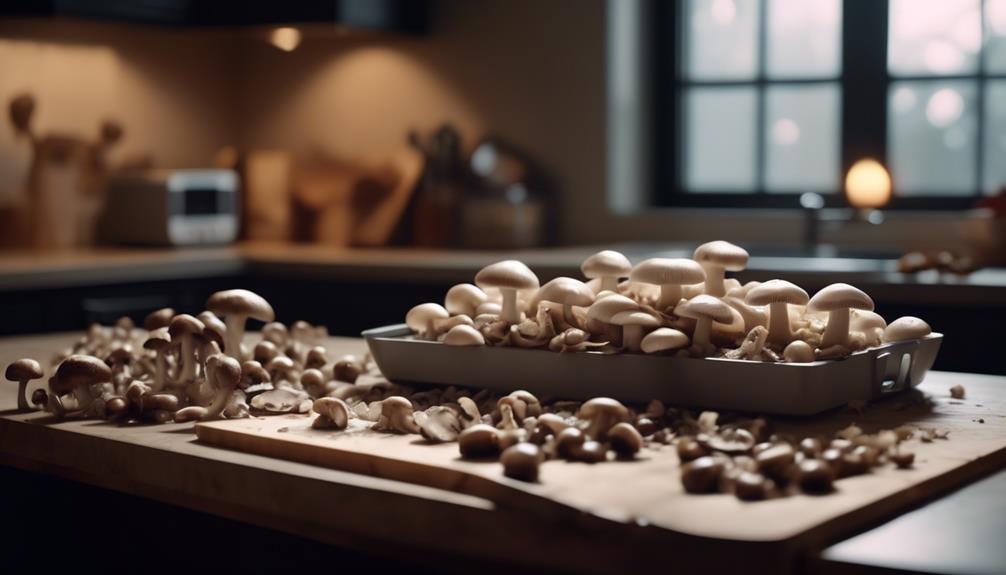Just as a squirrel stores nuts for the winter, you might find yourself wanting to preserve the bounty of mushrooms that autumn has provided.
You've done the foraging or taken advantage of a sale at the market, and now you're faced with more mushrooms than you can use before they spoil. Freezing mushrooms is a practical method to extend their shelf life, but it's not as simple as tossing them into the freezer.
You'll need to prepare them properly to maintain their texture and flavor. You'll start by selecting the right kind of mushrooms and cleaning them without soaking them through.
What comes next is a step that can make or break the quality of your preserved fungi.
So, let's explore how to ensure your mushrooms can emerge from their chilly slumber as delectable as they were the day you picked or purchased them.
Key Takeaways
- Select fresh, firm, and blemish-free mushrooms for freezing
- Thoroughly clean mushrooms without soaking them to prevent a soggy texture
- Blanch mushrooms to cleanse the surface, preserve color, and inactivate enzymes
- Package mushrooms in airtight containers or freezer bags, removing as much air as possible before sealing
Selecting Suitable Mushrooms
When choosing mushrooms to freeze, opt for ones that are fresh, firm, and free from blemishes to ensure the best quality after thawing. Mushroom varieties each have their own freshness indicators to watch for. For instance, button mushrooms should be compact and white, while shiitakes are best when their caps are uncracked and their edges are curled slightly downwards.
You'll want to look for mushrooms with a smooth texture and a uniform color that's characteristic of their type. Any signs of sliminess, wrinkles, or dark spots can indicate they're past their prime. The stems should be intact and the gills, which are the underside of the mushroom caps, ought to be free from moisture. This is important because excess water can lead to ice crystals forming, which will affect the mushroom's texture when you defrost them.
Additionally, give them a sniff. They should have a mild, earthy smell. A sour or off odor is a telltale sign they're starting to spoil. Remember, the better the mushrooms look and smell before freezing, the better they'll hold up in the freezer. Choosing the best specimens extends their shelf life and ensures your dishes will be flavorful and fresh when it's time to cook.
Preparing Your Mushrooms
Begin the preparation process by thoroughly cleaning your mushrooms with a soft brush or a damp cloth to remove any dirt or debris. Mushroom cleaning is crucial to ensure they're free of any grit that could spoil the texture and taste once frozen. Avoid soaking them, as mushrooms are porous and will absorb water, which can lead to a soggy texture when thawed.
Once they're clean, it's time to address slicing techniques. If you're working with larger mushrooms like portobellos, you'll want to slice them into even pieces to ensure uniform freezing and defrosting. Smaller varieties, such as button mushrooms, can be left whole if you prefer, but halving or quartering them can make for more convenient use later on.
Your slices should be consistent in thickness, aiming for about a quarter-inch if possible. This not only helps them freeze evenly but also makes for easier cooking directly from the freezer. Lay your sliced mushrooms out on a kitchen towel and pat them dry to remove any excess moisture. This step is essential, as excess water can turn into ice crystals and affect the mushrooms' texture.
Once prepped and patted dry, your mushrooms are ready for the next stage of freezing.
Blanching Process Explained
After preparing and patting your mushrooms dry, it's crucial to blanch them before freezing to lock in flavor and texture. Blanching is a quick process of boiling mushrooms for a short period, then plunging them into ice water to halt the cooking. This step offers several blanching benefits:
- It cleanses the surface of the mushrooms, removing any residual dirt.
- Enzymes that cause flavor and texture degradation are inactivated.
- The vibrant color of your mushrooms is preserved, making them more appealing when thawed.
Here's how you do it:
- Boil a pot of water and add a pinch of salt.
- Prepare a bowl of ice water.
- Submerge mushrooms in boiling water for 1-2 minutes.
- For button mushrooms, 1 minute is often enough.
- For denser varieties, like portobellos, aim for 2 minutes.
- Quickly transfer them to the ice water to cool down immediately.
If you're looking for blanching alternatives, consider steam blanching. It's gentler on the mushrooms, preserving more of their natural flavor and nutrients:
- Use a steamer basket over boiling water.
- Steam for the same 1-2 minutes, then cool in ice water.
Packaging Mushrooms for Freezing
Now that your mushrooms are blanched, it's time to package them properly for freezing to ensure they maintain their quality.
Regardless of the mushroom varieties you've prepared, the key is to use the right storage containers. You'll want containers that are airtight to prevent freezer burn and protect the mushrooms from absorbing other flavors and odors from your freezer.
Choose freezer bags or rigid plastic containers designed for freezer storage. If you're using bags, make sure to squeeze out as much air as possible before sealing. This step is crucial to limit exposure to air, which can degrade the mushrooms' texture and flavor over time. For containers, fill them to the top to minimize the amount of air trapped inside.
When packing, consider portion sizes. You might want to freeze mushrooms in quantities you'll commonly use for recipes. This way, you won't have to defrost more than you need at one time.
Label your containers or bags with the date and type of mushroom to help keep track of freshness and ensure you're using the oldest ones first.
Proper packaging will keep your mushrooms fresh for up to 12 months, so you can enjoy their flavor long after the season has passed.
Thawing and Using Frozen Mushrooms
When you're ready to cook with your frozen mushrooms, thaw them gently in the refrigerator overnight to preserve their texture and flavor. This slow-thaw method is key for keeping the mushrooms' quality intact for your mushroom recipes.
Once thawed, the mushrooms might release some water. Simply drain this excess liquid before adding them to your dish. If you're short on time, you can skip the thawing process for certain recipes. Frozen mushrooms work wonderfully in:
- Soups
- They'll defrost quickly in the hot broth
- Sauces
- They'll integrate seamlessly as they simmer
Remember, if you're planning to sauté or fry them, it's best to thaw first to avoid excess water which can lead to sogginess. Always check the storage duration on your frozen mushrooms. They're best used within:
- Six months
- For optimal flavor and texture
- A year
- If you're okay with a slight quality compromise
Thawing and using your frozen mushrooms correctly ensures that you'll have a delicious ingredient ready for a variety of dishes. Whether you're prepping a quick weeknight meal or an elaborate feast, those frozen fungi are a convenient and tasty addition to your cooking arsenal.

